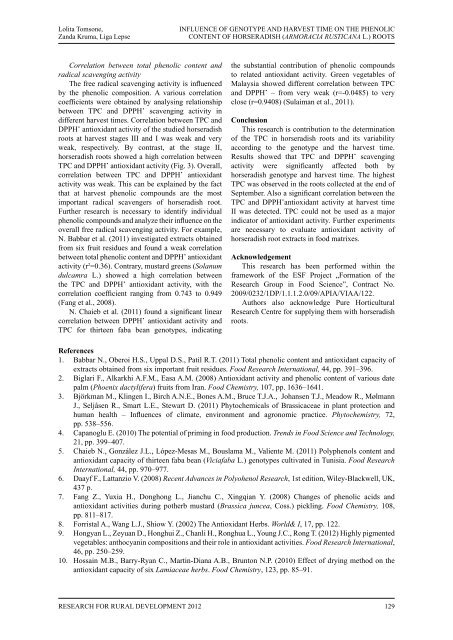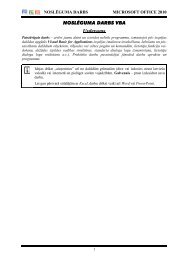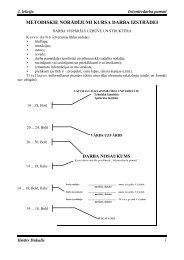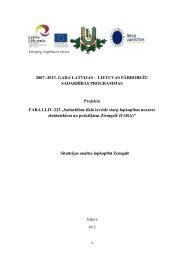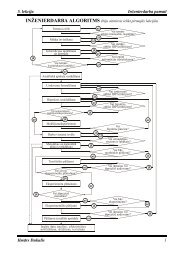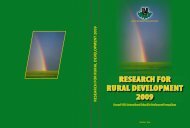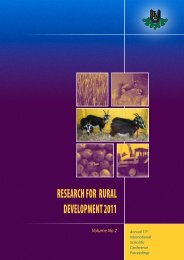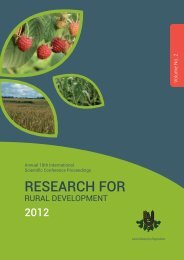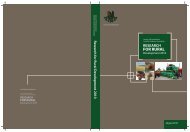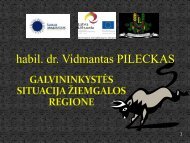LATVIA UNIVERSITY OF AGRICULTURE - Latvijas ...
LATVIA UNIVERSITY OF AGRICULTURE - Latvijas ...
LATVIA UNIVERSITY OF AGRICULTURE - Latvijas ...
- No tags were found...
Create successful ePaper yourself
Turn your PDF publications into a flip-book with our unique Google optimized e-Paper software.
Lolita Tomsone,Zanda Kruma, Liga LepseINFLUENCE <strong>OF</strong> GENOTYPE AND HARVEST TIME ON THE PHENOLICCONTENT <strong>OF</strong> HORSERADISH (ARMORACIA RUSTICANA L.) ROOTSCorrelation between total phenolic content andradical scavenging activityThe free radical scavenging activity is influencedby the phenolic composition. A various correlationcoefficients were obtained by analysing relationshipbetween TPC and DPPH˙ scavenging activity indifferent harvest times. Correlation between TPC andDPPH˙ antioxidant activity of the studied horseradishroots at harvest stages III and I was weak and veryweak, respectively. By contrast, at the stage II,horseradish roots showed a high correlation betweenTPC and DPPH˙ antioxidant activity (Fig. 3). Overall,correlation between TPC and DPPH˙ antioxidantactivity was weak. This can be explained by the factthat at harvest phenolic compounds are the mostimportant radical scavengers of horseradish root.Further research is necessary to identify individualphenolic compounds and analyze their influence on theoverall free radical scavenging activity. For example,N. Babbar et al. (2011) investigated extracts obtainedfrom six fruit residues and found a weak correlationbetween total phenolic content and DPPH˙ antioxidantactivity (r 2 =0.36). Contrary, mustard greens (Solanumdulcamra L.) showed a high correlation betweenthe TPC and DPPH˙ antioxidant activity, with thecorrelation coefficient ranging from 0.743 to 0.949(Fang et al., 2008).N. Chaieb et al. (2011) found a significant linearcorrelation between DPPH˙ antioxidant activity andTPC for thirteen faba bean genotypes, indicatingthe substantial contribution of phenolic compoundsto related antioxidant activity. Green vegetables ofMalaysia showed different correlation between TPCand DPPH˙ – from very weak (r=-0.0485) to veryclose (r=0.9408) (Sulaiman et al., 2011).ConclusionThis research is contribution to the determinationof the TPC in horseradish roots and its variabilityaccording to the genotype and the harvest time.Results showed that TPC and DPPH˙ scavengingactivity were significantly affected both byhorseradish genotype and harvest time. The highestTPC was observed in the roots collected at the end ofSeptember. Also a significant correlation between theTPC and DPPH˙antioxidant activity at harvest timeII was detected. TPC could not be used as a majorindicator of antioxidant activity. Further experimentsare necessary to evaluate antioxidant activity ofhorseradish root extracts in food matrixes.AcknowledgementThis research has been performed within theframework of the ESF Project „Formation of theResearch Group in Food Science”, Contract No.2009/0232/1DP/1.1.1.2.0/09/APIA/VIAA/122.Authors also acknowledge Pure HorticulturalResearch Centre for supplying them with horseradishroots.References1. Babbar N., Oberoi H.S., Uppal D.S., Patil R.T. (2011) Total phenolic content and antioxidant capacity ofextracts obtained from six important fruit residues. Food Research International, 44, pp. 391–396.2. Biglari F., Alkarkhi A.F.M., Easa A.M. (2008) Antioxidant activity and phenolic content of various datepalm (Phoenix dactylifera) fruits from Iran. Food Chemistry, 107, pp. 1636–1641.3. Björkman M., Klingen I., Birch A.N.E., Bones A.M., Bruce T.J.A., Johansen T.J., Meadow R., MølmannJ., Seljåsen R., Smart L.E., Stewart D. (2011) Phytochemicals of Brassicaceae in plant protection andhuman health – Influences of climate, environment and agronomic practice. Phytochemistry, 72,pp. 538–556.4. Capanoglu E. (2010) The potential of priming in food production. Trends in Food Science and Technology,21, pp. 399–407.5. Chaieb N., González J.L., López-Mesas M., Bouslama M., Valiente M. (2011) Polyphenols content andantioxidant capacity of thirteen faba bean (Viciafaba L.) genotypes cultivated in Tunisia. Food ResearchInternational, 44, pp. 970–977.6. Daayf F., Lattanzio V. (2008) Recent Advances in Polyohenol Research, 1st edition, Wiley-Blackwell, UK,437 p.7. Fang Z., Yuxia H., Donghong L., Jianchu C., Xingqian Y. (2008) Changes of phenolic acids andantioxidant activities during potherb mustard (Brassica juncea, Coss.) pickling. Food Chemistry, 108,pp. 811–817.8. Forristal A., Wang L.J., Shiow Y. (2002) The Antioxidant Herbs. World& I, 17, pp. 122.9. Hongyan L., Zeyuan D., Honghui Z., Chanli H., Ronghua L., Young J.C., Rong T. (2012) Highly pigmentedvegetables: anthocyanin compositions and their role in antioxidant activities. Food Research International,46, pp. 250–259.10. Hossain M.B., Barry-Ryan C., Martin-Diana A.B., Brunton N.P. (2010) Effect of drying method on theantioxidant capacity of six Lamiaceae herbs. Food Chemistry, 123, pp. 85–91.Research for Rural Development 2012129


